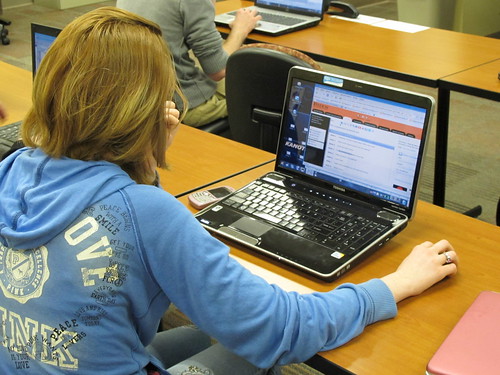I teach an integration class at UFindlay which is required of all education undergraduate majors. One of the Ohio requirements for the course is that all students demonstrate proficiency in “multiple operating systems.” Until this year, I was fortunate enough to have the class in a lab with duel-boot iMacs. Each day the students could boot into the OS of their preference, but on the days we were doing OS specific activities everyone would have to use either Windows or OS X. In our case, “multiple” has always been “two.”
This semester the iMac lab schedule had to handle some extra digital art classes. The iMacs are the only computers in our building which have the Adobe Creative Suite software and that software is only on the OS X side. So I was asked to move my class to a PC lab. Knowing my students had to demonstrate proficiency in multiple operating systems, I hatched a plan to boot the computers from a Linux Live DVD for the assignments requiring a second OS.
 On Tuesday my students created a tutorial using PowerPoint. Using screen captures, each student created a presentation showing all the steps required to insert a picture into a Word document. Here is my example.
On Tuesday my students created a tutorial using PowerPoint. Using screen captures, each student created a presentation showing all the steps required to insert a picture into a Word document. Here is my example.
http://www.slideshare.net/proftrusty/insert-a-picture-in-word
Each student must insert his or her own picture into the presentation. This makes it easier for me to identify who has submitted each file and also precludes them from sharing screen captures with each other.
On Thursday we repeated the assignment but used Kanotix Linux instead. This Debian based distribution had received good reviews for hardware identification. I have a lab of 28 Dell desktop computers, but in addition there are a dozen students who bring their own laptops to class. Kanotix worked fine on the lab computers, but I wasn’t sure how well it would work on the assortment of laptops we have. To complete the assignment, the students had to login to UFindlay’s Blackboard server. The assignment and the class pictures were in Bb. This was going to require a wireless network connection for the student laptops.
Kanotix worked on most of the student laptops. The inserted picture is a student using a Toshiba laptop booted from the Kanotix DVD. The assignment required the students to create a PowerPoint tutorial showing all the steps required to insert a picture into Open Office. Here is my example.
http://www.slideboom.com/presentations/151346/Open-Office-on-Linux
Kanotix includes Open Office as well as hundreds of other programs. The students used a screen capture utility to grab screens from Open Office. We did hit a snag when some USB drives wouldn’t work and students had to resort to emailing files to themselves. We found an archive utility which did permit us to add all the files into one zip file for easier email file management.
This was the first time I had done this particular activity in class. I was not sure how it would go, but overall I think it was a huge success. Having this exposure to Linux was not a big deal. Most of them will never use Linux on the desktop. The most important skill they picked up yesterday was learning something new in a short amount of time. In about an hour each student went from “I have never used Linux before” to “here is an artifact showing I can use Linux to create a presentation.” This is an important 21st century skill which all teachers need to understand. As technology changes ever so quickly, we all must be able to understand how these new tools work and how we can use them in our classrooms.

5 Responses to Linux in the classroom – 21st century skills